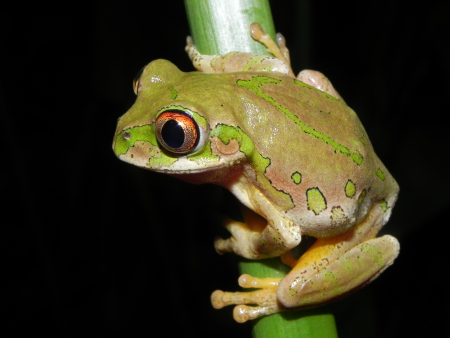FrogMAP — Frog Atlas of Southern Africa
Family Arthroleptidae
Leptopelis natalensis
Natal Tree Frog, Forest Tree Frog, Natalse Boompadda (A)
Species account was published under the name:
Leptopelis natalensis (Smith, 1849)
Red listing status: Least Concern

Photo by Evans Nick, 2012. URL: FrogMAP: 571
Distribution
L. natalensis is endemic to KwaZulu-Natal and the northeastern part of Eastern Cape Province of South Africa. It occurs along the northeastern coast from Sodwana Bay (2732DA) in the north to Manubi (3228BB) in the south. This species has a loud and unmistakable advertisement call. The atlas data are accurate and reasonably complete.
Habitat
The breeding and non-breeding habitat of this species is Coastal Forest, Sand Forest and Coastal Bushveld/Grassland in the Forest and Savanna biomes. L. natalensis is usually found near swamps or pans in fairly dense, indigenous forest, although it occasionally occurs in habitats similar to those inhabited by Hyperolius pickersgilli, such as stagnant water marshes.
Life history
Most breeding activity takes place in summer once the rainy season is well underway. Males usually begin calling at dusk from exposed positions up to 3 m above the ground in the foliage of trees and bushes close to, or overhanging, water. The females are usually much larger than males. Amplexus is axillary. Amplexing pairs move down to the ground where the female excavates a shallow burrow near the water’s edge in which c.200 light-yellow eggs are laid. The female fills the burrow, disguising its location with leaves and twigs (pers. obs). About 13 days later, the tadpoles leave the egg capsules and move towards the water with jumping and wriggling movements (Wager 1965). The remainder of larval development takes place in the usual way.
Predators are thought to include snakes and terrapins, while prey usually consists of large flying insects such as noctuid moths.
Conservation
The major threat to L. natalensis is habitat loss resulting from water drainage, invasions of alien plants, and afforestation. In several areas in KwaZulu-Natal, Eucalyptus plantations have lowered the water table to such a degree that many pans adjacent to coastal dune forest have completely disappeared.
L. natalensis occurs in several protected areas, for example, Krantzkloof Nature Reserve, Mkuze Game Reserve, Greater St Lucia Wetland Park, and Twinstreams-Mtunzini Natural Heritage Site. It is fairly common within its range, but local populations are probably quite small. The species does not appear to require any special conservation action at present.
Current distribution map
 Undated records;
Undated records;  pre-1996;
pre-1996;  1996 to 2002;
1996 to 2002;  2003 to present
2003 to present
Citation:
- Web:
FrogMAP. 2024. Leptopelis natalensis (Smith, 1849). Animal Demography Unit. Accessed from http://frogmap.adu.org.za/?sp=680; on 2024-04-18 02:04:51. - Book:
Minter L.R., Burger M., Harrison J.A., Braack H.H., Bishop P.J. & Kloepfer D. (eds). 2004. Atlas and Red Data book of the frogs of South Africa, Lesotho and Swaziland. SI/MAB Series no. 9. Smithsonian Institution, Washington, D.C. Published by the Smithsonian Institution and the Avian Demography Unit (now Animal Demography Unit).




